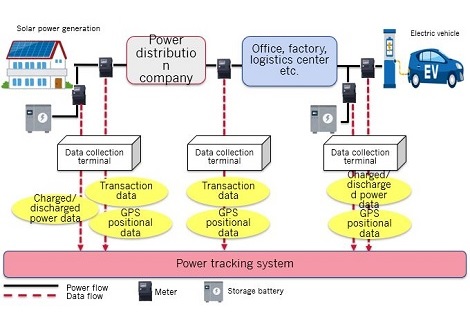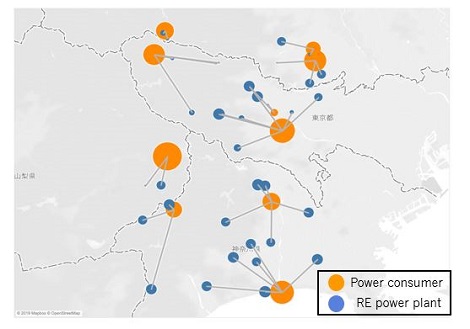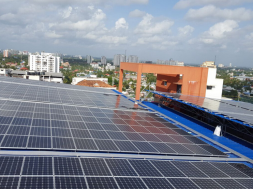ORIX to Start Joint Research into a Tracking System to Encourage Local Production and Consumption of Power
TOKYO, Japan: ORIX Corporation (“ORIX”) announced today it will collaborate with The University of Tokyo on the joint research into a tracking system that leverages block chain technology to prove the history of power from supply to consumption.
Demonstration testing will be conducted on a tracking system the origin of power generated from renewable energy, including its production site, source of power, production time and suppliers. Information is based on power transaction data and GPS information using block chain technology. Matching verification of distributed networks*1 that are simultaneous/commensurate*2 with multiple power sources such as solar power generators and general households, and multiple consumption sites such as offices, factories and electric vehicles will also be implemented.
RE Mileage*3, a system for minimizing the geographical power transmission distance between multiple generation sites and sites of consumption, will be developed to promote the local production and consumption of renewable energy. As this will lead to users purchasing power from local power sources, it is hoped that it will contribute to vitalizing local economies while also reducing transmission loss and enabling the efficient use of power.
In the future, ORIX will work to develop comprehensive power networks including demand response*4 (DR), virtual power plants*5 (VPP) using electric vehicles, as well as coordinating with the disaster systems of local municipalities with the aim of also applying this technology to social systems, such as utilizing electric vehicles as emergency power sources in areas affected by disasters.


In recent years, as social interest is increasing in the achievement of a carbon-free society and ESG investment, global movements at corporations and local municipalities aiming for RE100, whereby 100% of consumed power is renewable energy. However, an issue had arisen as the source of electricity was unable to be determined for conventional power supply services meaning that the site of production of renewable energy could not be proven. This was because the power produced at power plants is centralized on a power grid*6 before being sent to consumers such as corporations and individuals.
ORIX is proactively engaging in the development of power generation systems utilizing various types of renewable energy such as solar power, geothermal energy, wind power and biomass power, while also operating power supply facilities that contribute to distributed energy networks throughout Japan. As part of its research into the development of power distribution systems utilizing technology such as block chain technology, The University of Tokyo agreed to jointly engage in the aforementioned research in order to investigate a new power distribution service development foundation that could encourage the introduction of renewable energy. Ahead of anticipated changes in the social environment going forward, both ORIX and The University of Tokyo hope to contribute to the popularization of well-balanced renewable energy and the realization of a distributed energy network society.
*1 Distributed network: In contrast to a centralized type network that supplies power after centralizing it from large-scale power plants, a dispersed network enables the relatively small-scale use of power dispersed within a region in neighboring areas.
*2 Simultaneous/commensurate: As it is difficult to store electricity as it is, the supply and demand volume must constantly be matched in terms of total volume over 30 minutes.
*3 RE Mileage: RE stands for renewable energy. This system aims to quantitatively grasp energy transport distance (trademark currently being registered by ORIX).
*4 Demand response (DR): While the volume of power supplied is conventionally adjusted to match the amount of energy demand, DR refers to achieving simultaneous/commensurate amount by having the user adjust the amount of demand.
*5 Virtual power plant (VPP): Using IoT to control and group small-scale power plants and make them function like a single virtual power plant.
*6 Power grid: A single-chain system covering power generation, transformation, transmission and distribution in order to supply power from power plants to consumers.
About ORIX:
ORIX Corporation (TSE: 8591; NYSE: IX) is a financial services group which provides innovative products and services to its customers by constantly pursuing new businesses.
Established in 1964, from its start in the leasing business, ORIX has advanced into neighboring fields and at present has expanded into lending, investment, life insurance, banking, asset management, automobile related, real estate and environment and energy related businesses. Since entering Hong Kong in 1971, ORIX has spread its businesses globally by establishing locations in 37 countries and regions across the world.
Going forward, ORIX intends to utilize its strengths and expertise, which generate new value, to establish an independent ORIX business model that continues to evolve perpetually. In this way, ORIX will engage in business activities that instill vitality in its companies and workforce, and thereby contribute to society. For more details, please visit our website: https://www.orix.co.jp/grp/en/
(As of March 31, 2019)
Caution Concerning Forward Looking Statements:
These documents May contain forward-looking statements about expected future events and financial results that involve risks and uncertainties. Such statements are based on our current expectations and are subject to uncertainties and risks that could cause actual results that differ materially from those described in the forward-looking statements. Factors that could cause such a difference include, but are not limited to, those described under “Risk Factors” in the Company’s annual report on Form 20-F filed with the United States Securities and Exchange Commission and under “(4) Risk Factors” of the “1. Summary of Consolidated Financial Results” of the “Consolidated Financial Results April 1, 2018 – March 31, 2019.”















